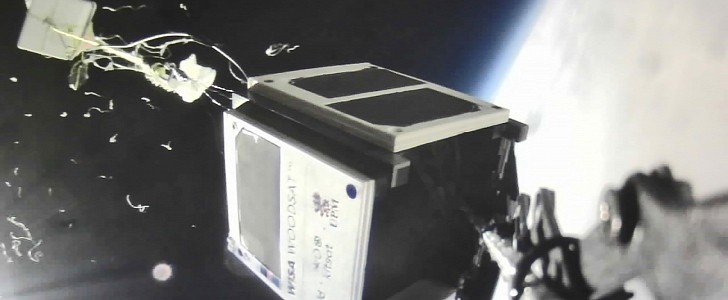On June 12th, the world's first wooden satellite completed a successful stratospheric flight when a test model was launched from the Heureka Science Center in Vantaa, Finland. The primary goal of the test flight was to evaluate the satellite's systems, particularly how the camera attached to the selfie stick operates in space.
This small 10x10x10 cm (3.9x3.9x3.9 inches) wooden smart box goes by the name of WISA Woodsat. It's a nanosatellite designed and built by Arctic Astronautics, and it is based on its Kitsat, a fully functional 1-unit CubeSat.
It weighs just two pounds (about 1 kg), and it's quite simple looking, having a suite of onboard sensors, including two cameras, one of which is attached to a deployable boom for "exterior imaging."
Powered by nine small solar cells, it's made of WISA-Birch plywood (hence the name), and it's coated against strong UV radiation using a new atomic layer deposition method.
A test model was carried by a high-altitude balloon to the stratosphere on Saturday. It was launched at 13:25 EET, and it flew for two hours and 54 minutes. The satellite reached its highest altitude in the upper atmosphere at 31 km (19 miles) above Mäntsälä, Finland.
Shortly after, the balloon exploded as planned. The wooden satellite took a selfie at that very moment, then it began its descent using a parachute. It landed safely in a forest, a few miles southwest of the city of Lahti, where the recovery team found it on top of a tree.
Because the test model performed as expected throughout the flight, the preparations for the actual space flight will proceed as scheduled. By the end of June, the WISA Woodsat satellite's flight model and its spare will be ready for takeoff.
Until then, the spare model will be put through intensive testing at the European Space Agency's technical facility in the Netherlands. In a specially designed shaker, the wooden satellite will be placed in a space simulator and subjected to the shocks of the rocket ride.
The satellite will be launched into space from a Rocket Lab's Electron rocket, and it will orbit the Earth every hour and a half at an altitude of 500–550 km (310-342 miles). The mission's purpose is to spend two years in space studying the behavior of plywood and collecting data on what could be the future of sustainable space travel.
It weighs just two pounds (about 1 kg), and it's quite simple looking, having a suite of onboard sensors, including two cameras, one of which is attached to a deployable boom for "exterior imaging."
Powered by nine small solar cells, it's made of WISA-Birch plywood (hence the name), and it's coated against strong UV radiation using a new atomic layer deposition method.
A test model was carried by a high-altitude balloon to the stratosphere on Saturday. It was launched at 13:25 EET, and it flew for two hours and 54 minutes. The satellite reached its highest altitude in the upper atmosphere at 31 km (19 miles) above Mäntsälä, Finland.
Shortly after, the balloon exploded as planned. The wooden satellite took a selfie at that very moment, then it began its descent using a parachute. It landed safely in a forest, a few miles southwest of the city of Lahti, where the recovery team found it on top of a tree.
Because the test model performed as expected throughout the flight, the preparations for the actual space flight will proceed as scheduled. By the end of June, the WISA Woodsat satellite's flight model and its spare will be ready for takeoff.
Until then, the spare model will be put through intensive testing at the European Space Agency's technical facility in the Netherlands. In a specially designed shaker, the wooden satellite will be placed in a space simulator and subjected to the shocks of the rocket ride.
The satellite will be launched into space from a Rocket Lab's Electron rocket, and it will orbit the Earth every hour and a half at an altitude of 500–550 km (310-342 miles). The mission's purpose is to spend two years in space studying the behavior of plywood and collecting data on what could be the future of sustainable space travel.




